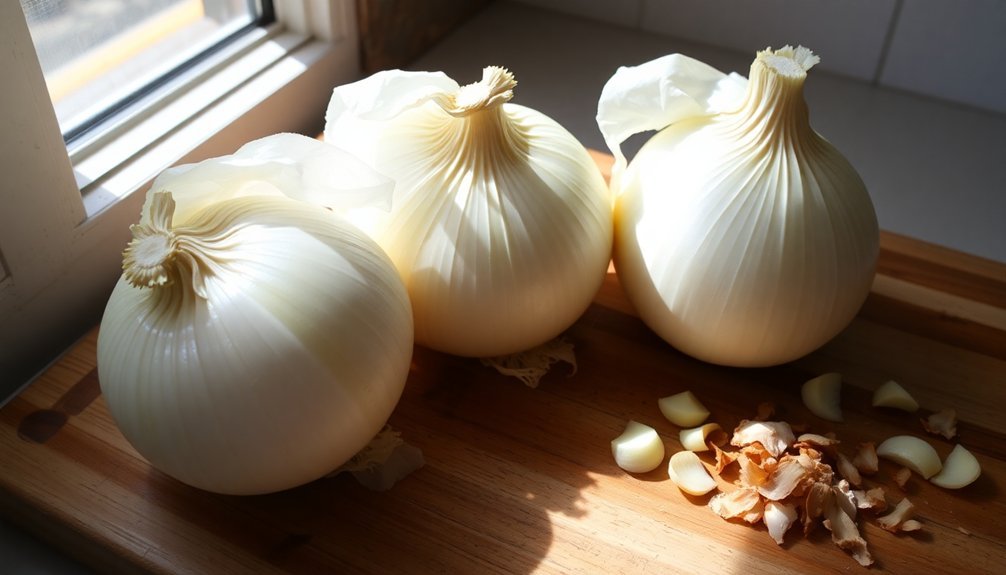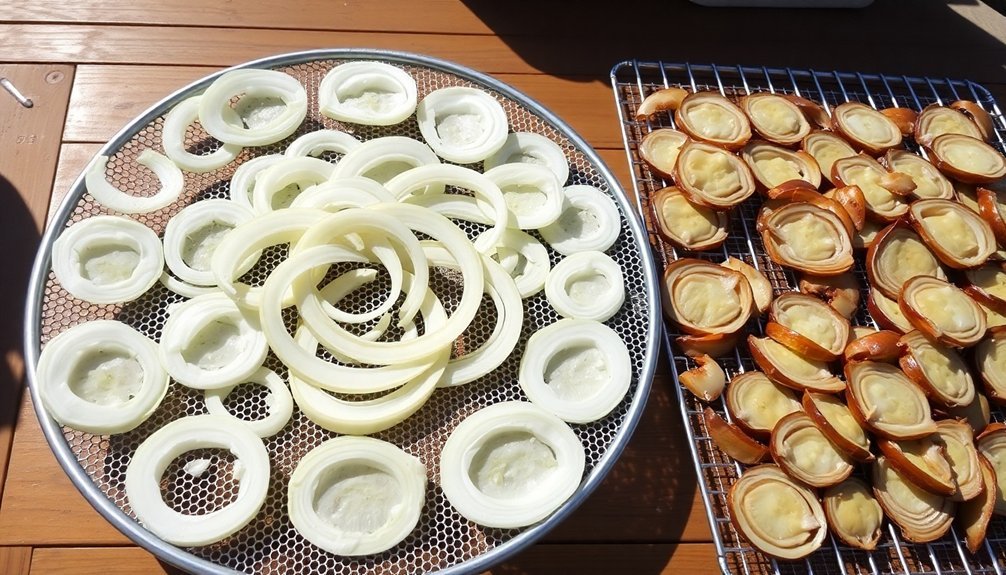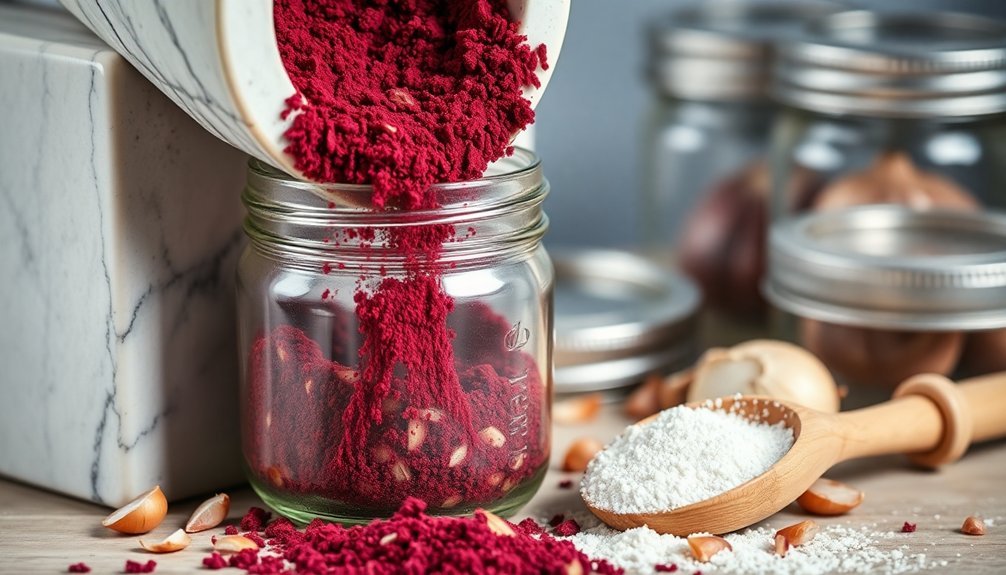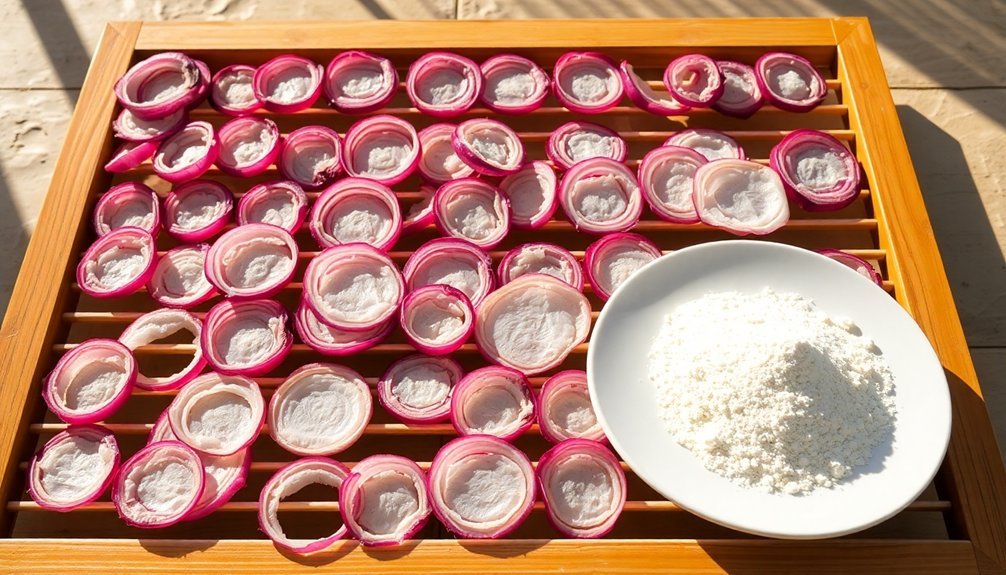To make sun-dried onion powder, start by selecting firm storage onions without decay or damage, as they're ideal for their lower moisture content. You'll want to slice them uniformly between 1/8 to 1/4 inch thick using a mandoline or sharp knife. Set up your drying racks in direct sunlight at 85-95°F, covering with cheesecloth to protect from insects while maintaining airflow. Rotate the slices twice daily and dry for 4-6 days until they snap cleanly when bent. Once dried, grind the pieces into powder using short pulses in a food processor and store in airtight containers. Master these fundamentals and you'll reveal the secrets to pure, preservative-free onion powder.
Selecting Fresh Onions

Three key factors determine the quality of your onion powder: variety selection, maturity, and proper handling.
Choose your onions based on the flavor profile you want – red onions deliver spicy notes perfect for seafood dishes, while pink onions offer a sweeter taste without astringency. White onions work well for general purposes.
Look for onions that have naturally flopped tops, indicating they're fully mature and ready for harvest. You'll want to pick them in late summer or early fall when they've developed dry necks. Storage onions are ideal for making powder since they contain less moisture and cure more effectively.
Before processing, verify your onions are free from decay and damage. Handle them gently to prevent bruising, and clean off excess soil.
For the best drying results, keep them in a well-ventilated area between 75°F and 85°F, away from direct sunlight.
Proper Slicing Methods
Four essential slicing techniques will determine the success of your onion powder. First, you'll need to cut your onions between 1/8 to 1/4 inch thick – thinner slices dry faster and more evenly. Using a mandoline or sharp knife, guarantee your cuts are uniform to achieve consistent drying rates and prevent over-drying.
Convert your slices into rings whenever possible, as they'll dry more quickly due to increased surface area exposure. It's fine if the rings overlap slightly on your dehydrator trays. You can also use a food processor for efficient and uniform chopping.
Before you start slicing, don't forget to remove any soft spots, papery skins, and green tops from your onions. You'll want to cut off the tough root ends too. A thorough cleaning before slicing will eliminate any dirt and guarantee the best quality powder.
Sun-Drying Setup

While proper slicing sets the foundation for your onion powder, the sun-drying method offers a natural, energy-efficient alternative to dehydrators and ovens. You'll need to carefully monitor weather conditions and protect your onions from insects and debris during the drying process. For optimal results, slice onions to ¼ inch thickness before placing them on drying racks.
| Equipment | Temperature | Time Frame |
|---|---|---|
| Drying racks | 85-95°F | 4-6 days |
| Mesh screens | Sunny days | 6-8 hours daily |
| Glass jars | Avoid rain | Check hourly |
| Cheesecloth | Low humidity | Bring in at night |
| Parchment paper | Direct sun | Rotate twice daily |
Set up your drying station in a sunny, well-ventilated area. Cover onion slices with cheesecloth to protect them from insects while allowing airflow. Bring your onions inside at night to prevent moisture absorption, and continue the process until they're completely dry and brittle.
Testing Dryness Levels
Properly testing the dryness of your onions is essential for creating shelf-stable powder that won't clump or spoil.
Your dried onions should be completely brittle and snap cleanly when bent. If they're still flexible or feel slightly rubbery, they need more drying time.
You'll want to achieve a moisture content between 7-10% for ideal results, though lower levels around 2.8% are even better for preventing clumping. Since onions have high moisture content, proper drying is crucial to prevent microbial growth during storage.
To test this without specialized equipment, let the dried pieces cool completely, then break them – they should shatter with a crisp sound rather than bend.
If you're using a dehydrator or oven, aim for 125°F (52°C) for 10-18 hours, or 135°F for 4-6 hours until the pieces are thoroughly dry and breakable.
Grinding and Storage Techniques

Once your onions reach the ideal dryness level, it's time to transform them into powder.
You'll need a food processor, blender, or mortar and pestle to grind your dehydrated onion flakes. Use short pulses to avoid generating heat, and sift the powder through a sieve to guarantee uniformity.
If you notice any moisture in your powder, spread it on a cookie sheet and place it in a preheated (then turned off) oven for 20 minutes.
You can also add a teaspoon of arrowroot powder per cup to prevent clumping. Store your finished powder in airtight containers like Mason jars or mylar bags with oxygen absorbers.
Keep it in a cool, dry place away from sunlight. While dried flakes can last up to 12 months, powder typically maintains its best quality for 2-6 months.
Frequently Asked Questions
Can I Sun-Dry Onions During Rainy Season Using a Greenhouse?
Yes, you can sun-dry onions during rainy season in a greenhouse. You'll need to maintain temperatures between 68-86°F, guarantee good ventilation, and use fans for air circulation to achieve proper drying conditions.
Will Sun-Dried Onion Powder Have a Different Taste Than Dehydrator-Dried Powder?
Yes, you'll notice sun-dried onion powder has a more intense, concentrated flavor compared to dehydrator-dried powder. Sun drying creates slight caramelization and flavor variations, while dehydrator drying produces a more uniform, sweeter taste.
How Do I Prevent Insects From Contaminating Onions During Outdoor Drying?
You'll need to cover your drying onions with mesh screens or netting, keep the area clean of debris, place them in raised beds, and dry them during low-insect seasons. Regular inspections help catch problems early.
Can Different Onion Varieties Be Mixed When Making Powder?
Yes, you can mix different onion varieties when making powder. You'll get unique flavor profiles by combining sweet, sharp, and spicy varieties. Just remember that varying moisture contents may require different drying times.
Does Altitude Affect the Sun-Drying Time for Onions?
Yes, altitude affects your onion drying time. You'll find they dry faster at higher altitudes due to lower air pressure and humidity, though cooler temperatures at elevation might slightly slow the process.
In Summary
Creating your own sun-dried onion powder lets you control quality while saving money. You'll find that following proper selection, slicing, and drying methods makes a huge difference in the final product. Store your freshly ground powder in an airtight container, and you'll have flavorful seasoning ready whenever you need it. Remember, patience during the drying process guarantees the best results for your homemade onion powder.





Leave a Reply